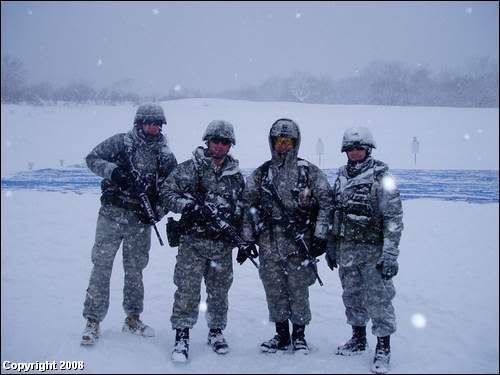
I am so glad I took time to read the newspaper so that I caught this article in the Shreveport Times. A good many Louisiana National Guard conducted their annual training far far from Louisiana. It was all part of ORIENT Shield 2008. THe article mentions that next year many more Louisiana National Guard personel will be trainin gin this exercise. THese exercises were conducted from Jan 28th to Feb 10th in Niigata Japan.
As the article goes into this was mostly a South Louisiana contigent but there were North Louisiana folks involved.
Anyway good article. There are a set of links including this interesting photo Gallery. Also a YouTube video of the unit in Japan: http://www.youtube.com/watch?v=NrxEuL__8wU
Hundreds of Louisiana Army National Guard soldiers, including many from northwest Louisiana, probably felt more like cold sushi than hot Cajun crawfish.They traveled to the snowy mountainous reaches of Japan to train with allies in the Japanese Ground Self-Defense Forces as part of the joint U.S. Army/Japanese Ground Self Defense Forces bilateral Field Training Exercise Orient Shield 2008 in Niigata from Jan. 24 to Feb. 10.
"I would have to say that this was my best Annual Training ever — in my 16 years of service," said Capt. Lance Magee, a former Shreveporter who once was part of the Shreveport-based 1/156th Armor Battalion and its successor unit, the 2/108th Cavalry Squadron but now is a company commander in the Lake Charles-based 3/156th Infantry Battalion. "While this was no 'vacation' — it was a training mission — we did get the opportunity to experience things we never have before (or likely will again), and experience familiar training in a new environment.
"Magee said he was "concerned at first when I heard they were taking a battalion of south Louisiana infantry to the frozen mountains of Japan, but I have to say this was a good idea and it was done right. We knew that we'd be performing two bilateral attacks during the second week, so the planners wisely worked in several days of ski training to start off the first week.
We were prepared, if not proficient."Magee said he and the roughly 250 other soldiers — mostly from south Louisiana but including a sprinkling of people from the Shreveport squadron — learned new ways of approaching old, familiar tasks."The Japanese Ground Self Defense Forces conduct training with a nearly exact AirSoft replica of their standard infantry rifle," he said. "This allows them to perform their close-quarters combat training anywhere, because they're only shooting little plastic BBs at each other. When we perform this training, it is either with no ammunition (allowing realistic placement of enemy in a building, but without actually pulling the trigger), with blanks (safety limitation of how close you can engage an enemy) or with live ammunition (no enemy force and required to be done on a live-fire range or specially constructed shoot-house.)"
The Japanese soldiers, he said, "just built some plywood walls in a gym, and we conducted two days of quality training that was set up and torn down in minutes. Good stuff."The training was a two-way street, though."We also showed them U.S. techniques for urban combat and sniper operations, which the 256th is quite proficient at," Magee said.That's an understatement.
During its deployment to Iraq in 2004 and 2005, the 256th Brigade Combat Team, also known as the Louisiana Tiger Brigade, conducted operations in some of the toughest parts of Baghdad, including the Abu Ghraib neighborhood, and was front-and-center in the rescue of kidnapped Australian Douglas Wood in June 2005."
The JGSDF are good troops, and it was interesting to see how their culture affects their training process," Magee said. "The JGSDF believe in very thorough preparation and execution of training, with a great deal of guidance coming from the top down. This differs from the U.S. methods of stating a higher commander's intent, and while a plan is made and rehearsed, a great deal of latitude is given the lowest commanders on the scene to modify the plan as necessary to meet that commander's intent.
As Gen. Eisenhower said in World War II: 'Before the battle, plans are everything, but as soon as battle is joined, plans are worthless.'"The trip was special for Magee due to a family connection to Japan just after the close of World War II.Magee's grandfather, Alexandria lawyer D.C. Murchison, was an Army Reserve Infantry captain who fought in the Pacific Theater of war."When the war ended, because he was a lawyer and there was a lot of legal work to be done in Japan, he was held over and assigned to defend several Japanese in the (war crimes) trials that followed,"
Magee said."As his grandson, I found the parallel intriguing: We both were civilian attorneys, reserve infantrymen, and worked closely with the Japanese."
The command structure for the deployment to Japan was Col. Jonathan Ball, 256th Brigade commander; 3/156th Infantry commander, Lt. Col. Michael Pryor; 3/156th Infantry Co. A commander Capt. Jeremy Falanga, and Magee, in command of 3/156th Infantry Co. B. Pryor previously served in the Shreveport-based 1/156th Armor as commander of its Charlie Company and its operations officer and during the deployment to Iraq was the brigade operations officer."
Company A is at Fort Polk and Company B is at Camp Beauregard," Magee said. But "we deployed with soldiers from across the brigade —nobody was left out. In my Company I picked up a squad-plus 2/108th Cavalry guys that I was glad to see again, as well as some 3/156th Co. D and 1/141st Field Artillery guys."
No comments:
Post a Comment